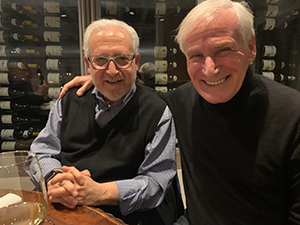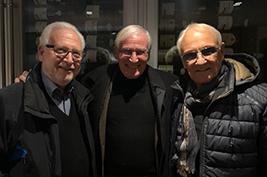Passion, Persistence, and Generosity: Remembering Alain Cribier
Martin Leon and Alain Cribier not only collaborated but also enjoyed a friendship spanning more than 25 years.

This Off Script evolved out of an in-person interview between Managing Editor Shelley Wood and Martin Leon, MD. It has been edited and redacted for clarity and flow. Hear more of their conversation in the February Heart Sounds podcast.
When did you first meet Alain Cribier?
I met Alain in the 1980s. He had recently done the world’s first balloon aortic valvuloplasty, which was a remarkable procedure, with Brice Letac in France. No one had ever done it before, and Alain was elated with the initial outcomes. He was a fairly diminutive person who didn’t easily excite—he was fairly humble, soft spoken—but in this instance he was very enthusiastic. Patients with inoperable aortic stenosis, at the time, had very little in the way of recourse, and Alain and his team had a very successful procedure. That was the starting point.
Where did he take that enthusiasm?
From that moment on, Alain became a very strong proponent of trying to spread the word about what he had done. He began teaching courses, he began traveling, he began going to labs and practicing and perfecting the skill of balloon valvuloplasty, and he became fairly well known as the premier practitioner of balloon valvuloplasty, which is one of the earliest catheter-based valve procedures ever done.
What was clear, however, was that results with valvuloplasty were not as good as we had originally hoped or intended. We could see some acute benefits, but the recurrence rate was extremely high and the complications at times were unforgiving in these very sick patients. So, in Alain’s mind, and not too many years after this all began, he began to thoughtfully consider what could be the next step.
How did your paths cross?
This was in the dawn of the era of stents. At the time, I was working with Julio Palmaz on stents and we had begun to do the coronary work, so you can imagine how our minds—mine and Alain’s—started to intersect. In the coronaries, we had found a way to be able to secure a device in a calcified vascular structure—could a stent then be a platform that would improve the results of what he was trying to achieve in the valve?
How did that first patient come about?
That very first case was a 57-year-old patient in Rouen, France, on April 16, 2002. Alain and I had communicated the night before by email and he was very nervous, obviously. But this was a desperately ill man who had cardiogenic shock and couldn't be treated by surgery because of comorbidities. He couldn't be intubated because he had severe lung disease, so this procedure was done without general anesthesia, and without the guidance of transesophageal echo, in a patient with markedly depressed LV function and multiple recent episodes of shock.
From the start, Alain was completely confident that it was possible. He had done a balloon valvuloplasty on this same patient several days before to try to get him out of a bad situation, so he understood the anatomy and he was very confident with the equipment, and was anxious to go ahead. He emailed me the night before to ask my opinion and I could hear his enthusiasm in his words: that he felt that the technique was ready and he himself was ready to do this. You never know in a situation like this, but the patient was just 57 and so desperately ill. There really were no other options, so we agreed that this was the right kind of case to try.
Not many people realize how much effort went into the preparation of that first case. By then, Alain had done over a hundred procedures in the animal laboratory, perfecting the technique and looking at variations of the procedure. So he, along with Hélène Eltchaninoff and Christophe Tron, went ahead.
What can you tell us about the procedure itself?
It certainly was not an easy procedure, and there was a lot of emotion in that room. They didn't have access from the arterial side, so they had to do the much more complicated procedure, which was to cross the septum and go from the antegrade side, which is very difficult.
And, in the early days of this technique, when you actually inflated the balloon and deployed the device, it was very difficult to predict the exact location, and many times it would move. The technique we now use is that we rapidly pace the heart, which brings the blood pressure down. This stabilizes the cardiac motion and allows you to be able to deploy the valve in a more stationary environment. But in the beginning, the device could move a few millimeters or it could move a few centimeters, and you can imagine, anything that moves a few centimeters is no longer going to be in a correct landing zone. So the positioning of it before deployment was critical. That famous photo of them staring wide-eyed outside the frame, I think that was the anxiety that they were feeling. What happened in that first case was even more remarkable because the patient went into ventricular tachycardia. His heart literally stopped so there were these few seconds of calm when they deployed the valve, and then his heart restarted spontaneously.
How soon after did you hear how it went?
I spoke to Alain minutes after he had done the case, and he was enthusiastic to the point of tears. He kept saying: what do we do next, what's going to happen next? Because here was the proof of concept that you could literally transplant a heart valve in an awake patient on a beating heart. I think it was one of those existential moments when the results exceeded anyone's expectations. And this was in the most desperate of patients. We could have never imagined that this was going to be a procedure that could be a workhorse standard for the treatment of aortic stenosis. We thought this was going to be reserved for the sickest of the sick patients who had no other options.
It has been a remarkable journey, to think that that case, which so exciting at the time, could be then developed into a procedure that's been generalized now into literally millions of people.
What else would you like people to know about him?
 I know Alain will be remembered for doing that incredible first case, but there was so much more to him than that. First, he was an inspirational mentor. I can't tell you the dozens of people who've come up to me since he passed and have said they spent time with him, how generous he was, and how affecting he was in terms of influencing their careers.
I know Alain will be remembered for doing that incredible first case, but there was so much more to him than that. First, he was an inspirational mentor. I can't tell you the dozens of people who've come up to me since he passed and have said they spent time with him, how generous he was, and how affecting he was in terms of influencing their careers.
He was the kind of person that you would want as a mentor. Never critical. Always thoughtful and more than available. He certainly appreciated his role, but he really believed in this whole team concept. He built a wonderful team around him and encouraged everybody to view this as a team sport. He also knew how to enjoy himself and he enjoyed being with friends—he was a very social person and a very giving person, and incredibly generous with his time and with his expertise. When we did the first valve at Columbia, in June of 2005, Alain flew over to be with us in the case.
He was not close to our surgical colleagues because there was this perception that we were suddenly invading, yet again, another surgical space. But he had garnered remarkable respect amongst the surgeons for his thoughtfulness, for his knowledge, and for his skill, because he was really a profoundly effective and intuitive interventionalist and some of these skills cannot be taught. He was somebody who was truly gifted.
Alain also believed in the importance of valvular heart disease, not just what he was doing with TAVI, but even earlier. He started his quest in the 1980s with very humanitarian intentions. He developed the first mechanical metallic valvulotome to be able to treat mitral stenosis, developing a mechanical approach because the balloons that were being used were too expensive. He would go every month to India and treat people with this device that could be resterilized and reused, allowing for a technique that would allow this procedure to be done in patients with rheumatic heart disease in socioeconomically challenged and underserved populations. He believed strongly in that. More recently he was very anxious and upset—frustrated—that TAVI was not as readily available as he would like, that we couldn't really disseminate it to enough places because of economic barriers.
What, in your mind, were his core qualities?
One of the things I admired most was his persistence. Percutaneous valve replacement was a crazy enough idea that unless you had persistence, it would never have succeeded. You have to understand that the first group of patients we treated: half of them had cardiac arrest on the table. Literally half. After a while you begin to say, what am I doing? But he had this abiding faith that if we just persisted, and if we continued to be very thoughtful and we continued to progress, we'd be able to develop a consistent procedure that resulted in good outcomes, that would be reproducible, that we could teach others. Alain had this unique combination of passion and persistence and stubbornness. I don’t think that many people entering that space, dealing with such acutely ill patients and experiencing so many failures, would ever have been able to persist with that degree of thoughtful effort and creativity.
And he was creative in other areas, too, I gather.
Yes, that passion spread to other things, including music. He would always play at home, for his friends. I visited him in Rouen on a number of occasions and he’d always play. He loved playing, loved to perform—he was a bit of a ham—but he was incredibly talented and very generous with his friends.

To a certain extent, what he did in the cath lab was also a way of performing. You could see it in his tone, in his movements, in the way he proceeded, that he had that very precise but very creative approach that a musician must have, born of practice, but also intuition and his own emotions. He brought great emotion to whatever he did in medicine, too. I think his music and medicine, side by side, worked very well for him.
That juxtaposition of passion, perseverance, creativity, and humility is unusual in a person. He was a very unusual individual. It is an honor to have known someone like that and to be able to call him a friend.
Off Script is a first-person blog written by leading voices in the field of cardiology. It does not reflect the editorial position of TCTMD.
Martin B. Leon, MD, is a Professor of Medicine at Columbia University Irving Medical Center in New York, NY, as…
Read Full Bio

Comments